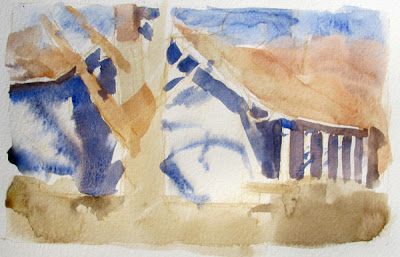Yesterday was warm and sunny for November, so Jeanette and I set up our sketching stools along the old post road in Red Hook, New York.
I was attracted to the craggy old sugar maple tree and how it cast soft shadows on the whitewashed side of the old house. The tree and house looked like bones bleaching in the morning sun. As I painted, the wind scattered the brittle leaves across the ground and the fleeting shadows drifted across the wall, making the house seem even more permanent by contrast.
Speaking of permanence and change, here's what the house looked like in 1936. It's known as the Martin homestead, built in the year of our country's founding in 1776.

Here's how the painting looked in its foundational stages. My goal at this point was to paint some warm tone around the outside of the picture to bring out the whiteness of the wall. Then I wet the wall's surface so that I could drop those shadow colors.
After that we went to our favorite diner, which was full of veterans who had just finished dedicating a new monument in the town's park.
-----
Tools: Schmincke Watercolor Pocket Set
Martin Homestead, Red Hook, NY
Previous GJ posts from the diner:
American Diner
War Jitters
While Waiting for Lunch
Two Creamers










9 comments:
Hi James...love your watercolor sketches (and everything else you do!). If there already isn't a post out there about your technique using the water color pencils, I'd love to see one. Thanks!
That is one beautiful sketch. You captured the autumn light and colors perfectly. And that is one well preserved building!
Do you suppose that's the same tree, and if so, did you "move" it closer to the building or does it just appear that way due to your angle?
Thanks, Tom. I wondered the same thing. I believe it's the same tree, because the growth is about right. The photo seems to be taken from more in front of the house, which moves the tree over quite a bit. I didn't consciously move anything, but I deleted a few things, such as a plastic picket fence out front.
Tami, I'm so glad you liked it. If you click on the categories of "Watercolor Painting" and "Paint Technique" in the blog index, you'll find a few videos and step by step photos.
Gorgeous! I love the dark, sharply etched shadows on the tree trunk set off by the softer blue ones on the wall. It looks like most of the finished color scheme is still very close to your original blue/brown/white block in, but creates the sense of a fully chromatic, clear sunny day.
Matthew
Nice sketch.
The tree shadows in the old photograph are very interesting, too.
- mp
A lovely image James. I assume it's small sketchbook in size and wonder how much time you invest in creating something like this. I can turn a small sketch into an all day struggle (I'm a beginner) and I suppose I'm curious about a benchmark. Thanks for this and all your other posts which are informative and entertaining. Gary
I have a question. How do you scan your work to get the colors right? When I scan my watercolors on the little HP scanner I have at home, it always loses anything delicate, so that I have to do heavy tinkering with the image in order to get it even close on the screen.
I did some plein air landscapes in watercolors for the first time last week, and as I worked I thought of the way you make sure to get all the relationships right among the various physical elements as well as the various degrees of light and shadow. Those things make a lot of difference.
Thanks, everybody.
Vicki, I just use my little pocket Canon digital camera instead of a scanner. I shoot the image in direct sunlight with a white card reflecting from the other direction to remove texture. I use the same camera to shoot the artwork in various stages during the process.
Check this new quick toy
http://www.wolframalpha.com/input/?i=Analyze+http%3A%2F%2F1.bp.blogspot.com%2F-TNouhuDWC7g%2FUKDF7EOvcBI%2FAAAAAAAAOP0%2FPR62RUvBeSk%2Fs400%2FOld%2BPost%2BRoad.sm.WT.jpg&dataset=
Post a Comment